| Author | Message | ||
Road_thing |
"annular protrusions" That just sounds nasty... rt | ||
Ceejay |
Pammy-only visit a doctor if somethings broken...which in this case I would think that you've just been in the sun too long... No congrats, I didn't do anymore than I normally do, which is to beg, poke, prode, and then finally cave in and charm my way to what I want...She does all the work, looking like she been stealing from the produce isle in the grocers... These "conversations" on badweb are pretty cool when you get away from the he said she said stuff..., this is top notch, sorry I don't have much to contribute... | ||
Bobpaul |
Blake, On your ideas about another mounting point out of plane: take a look at the bracket between both heads on the LH side of the bike. There is a fairly big bolt going into the head there. This would provide the third out of plane mounting point. Probably could design a strut to bridge between this point and the existing mount. It's not perfect because that bolt will be loaded in shear, but it's gotta be better than the stock set up. Another way to ket the two surfaces would be to counterbore the head and the bracket for a hollow dowel pin. Anybody try that one? Also on the stocker I bet they removed that lower bridge so that cooling air could get to the front center part of the cylinder head. Besides saving a few cents, of course. | ||
Blake |
Not my idea Paul. That third joint was DJ's idea. Dowel pin could work if shear loads aren't too high. They're probably pretty high. Good point too about the hinderance to airflow.  | ||
Djkaplan |
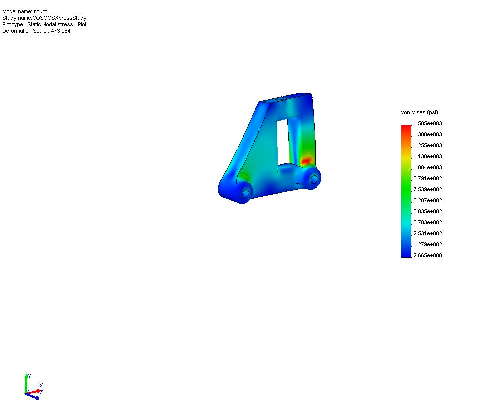 | ||
Djkaplan |
Just messin' round... | ||
Sarodude |
RT- I agree. I think Blake needs a proctologist. -Saro | ||
Blake |
Hey! I'm no Aggie! | ||
Rocketman |
I like the sound of this mating surface stuff but there's one thing that confuses. If once the bracket is bolted up tight to the head, why would such contact in the manners you describe make much if any difference given the assembly once bolted as a whole is rubber mounted to the frame? Shouldn't it be that the head and the bracket once bolted together should enjoy no (significant) movement other than what the rubber mount is designed to accommodate? So, what would occur if the two holes in the bracket had void bushes placed in them, then bolt to the head? Surely void bushing is the ultimate solution. Rocket | ||
Xldevil |
Hey. I´m happy with this bracket from Billet2 Race 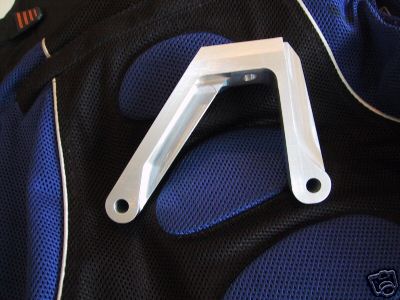 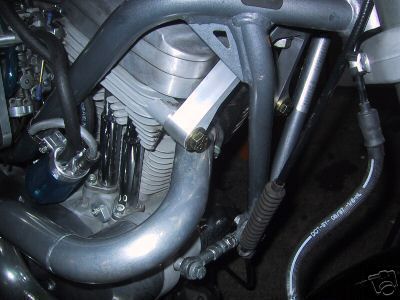 Also available for S1 and X1 http://stores.ebay.com/BILLET2RACE Ralph | ||
Blake |
Sean, How do you figure the bolt is breaking? If the bracket isn't moving wrt the cylinder head, the bolt would see no loading other than its preload from initial torquing and maybe some load due to thermal expansion of the aluminum. It takes cyclic loading to break the bolt. | ||
Djkaplan |
"I´m happy with this bracket from Billet2 Race" I use B2R footpegs and peg relocators. The stuff is top notch and reasonably priced. Excellent customer support, too. | ||
Rocketman |
Well Blake, I think the contact that was present between the rocker covers (see above pic's) and the mount are the cause this time. If that were not the case, to answer your question, I'd assume the amount of movement available from the rubber mount would be the 'weak' point in the rigidity of the design, thus allowing all the movement of the engine with front mount installed tight and correct, to pass through it - thus eliminating any ~(significant) movement at the mount to head contact area. I'm not an engineer so can't tell you a fact based diagnosis but I would have thought that those mounting bolts don't actually carry a load that should be affected by any minor movement or oscillation that would be able enough to snap either one of them after so much use. If that is the case then it is a poor design IMHO and thus required a different approach from the start. Perhaps if that's the case, void bushing should have seen to any problems caused by slight movement. All be it maybe void bushing might have required periodic replacement, but that's got to be better than what I've endured over the years. What do you reckon? Rocket | ||
Blake |
Movement at the rubber mount is not likely the root issue. The rubber mounting indeed may amplify or reduce the loads imparted to the bracket to cylinder head joint, it may do both depending on the particular situation, but that is not the issue. The system is absolutely designed to handle the applied loads. However, an improperly installed or functioning rubber mount might indeed be problematic and an instigating factor in the failures, sure it is possible. Movement there at the rubber mounting does not directly cause displacement of the bracket versus the cylinder head. The mounting of the bracket to the cylinder head is designed to carry all loads imparted to it. Something however has obviously prevented a few of those installations/assemblies from realizing their full required strength. It is doubtful that the failures is due to the rubber mounting scheme other than that is one part of the total path through with the loads of interest must travel. The design works well for the overwhelming vast majority of its implementations on Buell motorcycles. It seems obvious then that the root cause of the failure is not inherent in the design configuration. There then must be other factors involved, poor/improper assembly and/or preparation of faying surfaces may be one explanation, a failed front isolator may be another. BTW, the theory that a longer bolt with more length for thread engagement should be stronger in tension is mistaken. For a steel bolt in a tapped aluminum hole not much if any more than a couple diameters or so worth of threads nearest the faying surface are carrying any significant load. Me ignorant. I don't know what a void bushing is. Please explain. In the cases we've seen reported, it seems likely to me that the bolt may be failing due to excessive cyclic (fatigue) stresses. Those excessive cyclic stresses can only exist if the integrity of the bolt clamping preload is or becomes insufficient to maintain continuous effective clamping, enough clamping to resist by friction the displacement of the cylinder head boss wrt the mating bracket face. Once the clamping force is degraded enough to allow the bracket to slide or worse rock in a heal-to-toe type motion wrt the cylinder head boss, well you have a major cyclic stress (fatigue) situation. If only we had a broken bolt with an unmolested failure surface we could examine it and find tell-tale evidence of the mode of failure. Alas the bolt-head side falls out and is lost on the roadside somewhere while the embedded bit of bolt is necessarily extremely molested in order to achieve extraction. Your most recent experience shows a bracket bolt hole that appears to have experienced quite a bit of impacting against the shank of the bolt. Is that correct? You put that thing back together with the faying surfaces cleaned and roughed along with all else according to spec (slight lubricant film between bolt head and washer) and I bet you won't have any more problems with that assembly. (Message edited by Blake on September 05, 2006) | ||
Blake |
XL, That billet piece you show is indeed nearly what I would consider as optimum for the bracket. Very nice. | ||
Rocketman |
Me ignorant. I don't know what a void bushing is. Please explain. Oh no, not possible. No can do. If you read my post Sunday, September 03, 2006 - 08:30 am: you will see that there's a link posted where it says void bushing. Now I have to admit, I know what and pretty much how a void bush works in layman's terms but I didn't read the link I posted. I really put it there in case there was a language barrier thing going on. Eat your heart out Blake. That link is an engineers paradise! Your most recent experience shows a bracket bolt hole that appears to have experienced quite a bit of impacting against the shank of the bolt. Is that correct? No I don't believe it is. I think the rough surface disturbance on the bracket around the mating surface (bracket to head) might have been caused by the ever so slight protruding thread after the bolt snapped. The bolt holes are a tight fit on the one remaining good used bolt, and the two new bolts I purchased. So much so in fact that the still good used bolt was difficult to push through both holes without cleaning off the previously set thread lock. I'm pretty sure this failure was caused by my poor application of the bracket on this occasion. That small area of contact I showed in my pic's is pretty crucial I imagine. Rocket | ||
Al_lighton |
"That billet piece you show is indeed nearly what I would consider as optimum for the bracket." That billet piece has too short a grip length so that it can't use the stock grade 9 bolts, and it only comes with grade 8 bolts. That makes it a bit less than optimum to me. Al | ||
Rocketman |
I thought the stock bolts were grade 8? That's what I've purchased as replacements. The only way I can get higher grade locally is to go to a button head with Allen socket, which comes in at 12 grade. This needs rethinking. Rocket | ||
Xldevil |
Me and hundreds of german Buellistas are using the "Stenzel Stütze".This supports the front motor mount and bolts and shifts some of the momentum from the front rubber mount to the middle engine bracket. Probably the best assurance against broken head bolts ever creaeted,IMO. There is not a single report of a broken head bolt if the the Stenzel Stütze is used. http://www.stenzel-parts.de/14321.html 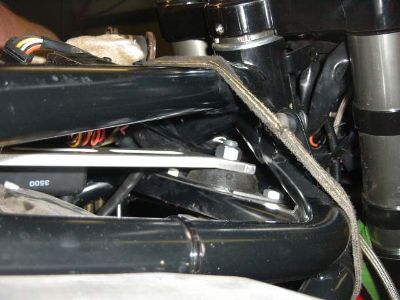 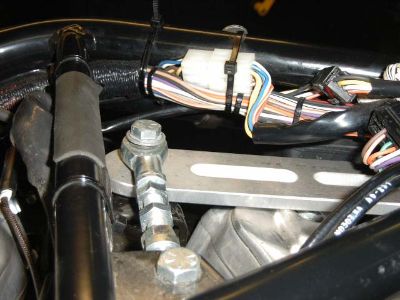 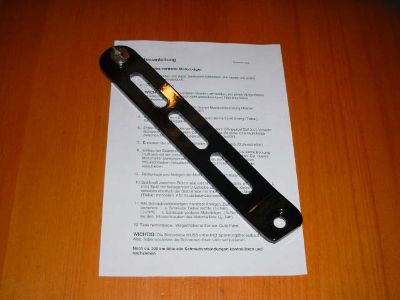 Btw. It is better to use bolts that are not absolutely inelastic.They do not tolerate any bending movements.They break! Thatfore I believe grade 8 bolts are better than grade 9 or 10 (Message edited by xldevil on September 05, 2006) | ||
Djkaplan |
Hey XL... thanks for the link. I never heard of Stenzel, but their stuff looks interesting. I'm definitely interested in the Stenzel Stutze. | ||
Blake |
Al, I agree about the undesirable shorter grip length that you call to our attention. That is not optimum and would increase the spring rate of the clamping bolt, a less desirable thing in this case I would think. What is a "grade 9" bolt? XLDevil, Intersting concept with that link. It would seem to possibly help limit the tendency for a heel-to-toe rocking at the bracket to cylinder head bosses interfaces. But that kind of change can also create a lot of problems too. What kind of duration of service have you and others accumulated with it? And what if any other problems havfe arrisen that might be related? Any broken engine mounting bolts? Re: ASTM grade 8 versus "higher" grade (specialty) bolts: I think a slight language barrier is in play in that I think that rather than more "elastice" you mean that grade 8 bolts are less "brittle" or more "ductile" than other "higher" grade bolts, since the higher the yield strength, the more elastic a steel bolt would be, "elastic" in this case being the ability to stretch and then return to original form without permanent deformation. I'm not really sure what a grade 9, 10 or 12 bolt is. There is no ASTM grade 9, 10, or 12 for bolts. I think some folks may be confusing the metric ISO classes with ASTM bolt grades. There are ISO class 8.8 (equivalent to ASTM grade 5) and 10.9 (equivalent to ASTM grade 8) bolts. Then the ISO also includes a class 12.9 for high strength socket head cap screws which like the ASTM socket head cap screws are the strongest conventionally supplied off the shelf fastener available. Ductility is evident when there is a large difference between yield (permanent stretching/deforming) strength versus ultimate (breaking) strength. You are absolutely right in that more ductility provides some margin against catastrophic failure in bolted joints or any structure for that matter, but in this case I think the failure mode is a progressive cyclic/fatigue failure not a sudden static stress fracture of the entire bolt section. Thus a less ductile higher yield strength bolt would be advantageous. Grade 8 bolts are really not very ductile either, and if you need to develop the extra clamping preload afforded by a higher strenght bolt, that would be an advantage. The Buell bolts, at least on my Cyclone, for the front engine bracket to cylinder head joints are not marked according to convention and so may be some kind of special bolt geometry and/or material. I'm not familiar with it. They may have special rolled-threads for higher strength and improved resistance to fatigue or they may be some specially engineered fastener either geometry wise or material strength wise. Rocket, I'd say your best bet is to purchase the OEM part or next best try to find an ASTM grade 8 bolt with rolled threads and identical geometry to the stock bolt. Be sure to use a hardened steel washer like originally provided. Interesting stuff. For reference on ASTM and ISO bolt grades/classes see... http://www.textronfasteningsystems.com/eng_tools_f/grades.html Some information about the benefits of rolled threads... http://www.bdthreadrolling.com/ | ||
Blake |
Pretty good basic information site for science of bolted joints... http://www.boltscience.com/pages/info.htm? | ||
Blake |
One other thing Sean, as you describe the bolt holes in the bracket as being very close fit, that probably kills my theory that the joint may have been designed to rely upon friction. That really was kind of silly of me since that would be highly unlikely in any kind of vibration saturated environment and for aluminum on aluminum especially. We use friction joints a lot in steel construction, but I've never seen them used on aircraft or other more highly engineered structural/mechanical systems that are subject to a lot of moderate to high frequency vibration. Should an engineer at Buell reads this, he/she will probably have a good chuckle on my account.  Sometimes I speak too quickly out of enthusiasm. Sometimes I speak too quickly out of enthusiasm. | ||
Xldevil |
What kind of duration of service have you and others accumulated with it? What kind of service? And what if any other problems have arisen that might be related? Any broken engine mounting bolts? None,no problems at all,referring to the experiences from http://www.borgforum.de/ by far the biggest tuber(Rohrrahmen) community in Europe. I think a slight language barrier is in play in that I think that rather than more "elastic" you mean that grade 8 bolts are less "brittle" or more "ductile" than other "higher" grade bolts, since the higher the yield strength, the more elastic a steel bolt would be, "elastic" in this case being the ability to stretch and then return to original form without permanent deformation you say it,I meant "ductile" Ralph (Message edited by xldevil on September 05, 2006) | ||
Rocketman |
Blake, thanks for that. I have as replacement bolts 8.8 ISO. That is the same strength as the one that failed. The button head with Allen socket I mentioned is more correctly what you refer to as an ISO class 12.9 high strength socket head cap screw. That I believe is where I might go next. Rocket | ||
Bobpaul |
Wow, I like the idea of the Stenzel Stütze. This is similar to what I suggested a few pages back. This idea is much better since it triangulates the mounting point! Blake, A couple of things... Metric socket head fasteners can be had in all grades, but Imperial socket heads are all grade 8 (or better, even though there is no spec as you have noted). The bolts Buell uses are, I believe, "L9" bolts. If you google L9 you should find the manufacturers site. Basically 180ksi steel. Also look in McMaster-Carr and search under L9 bolts and I think you'll find a picture that shows the head marking to be the same as what Buell (at least on my 2000 M2) uses. Also note that Buell calls these bolts "Grade 12" in the parts book. I think they just use them because it's a tradition at HD. The same bolts are used in the swingarm mount bracket to engine bolts. It seems to me that we need bolts that have high fatigue strength. Getting a high preload on the bolts means that when cycling the joint always stays in compression (the bolt in tension). If you remember from engineering design class the bolts need to stay way out in the tension zone. Certainly if there is stress reversal the joint will disintegrate in short order. It might be that these L9 bolts have better fatigue resistance than regular grade 8's. Maybe someone else knows that answer? | ||
Bobpaul |
Rocketman, Have you switched over to metric bolts? If I check my trusty Bossard handbook it says that a: 7/16-14 GR8 has a yield load of 61.5 kN and an M10 grade 12.9 has a yield load of 63.8 kN but then what are these L9 bolts anyway? Don't think there is enough "meat" to allow use of M12 bolts. Another interesting idea is to use a stud, which (in theory) would allow the unthreaded part to be located at the point of highest cyclic stress. I think you brought this idea up of having the non threaded shoulder portion in the bracket. | ||
Xldevil |
Hey XL... thanks for the link. I never heard of Stenzel, but their stuff looks interesting. I'm definitely interested in the Stenzel Stutze. The Stenzel parts are well known in Germany. The race header support is a very nice and durable part as well. 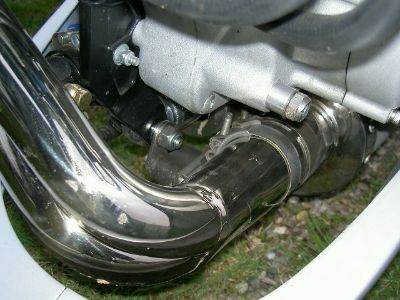 Maybe Al can contact Stenzel and distribute his parts in the U.S. | ||
Blake |
Rocket, "I have as replacement bolts 8.8 ISO. That is the same strength as the one that failed." You been using whimpy bolts mate! That be your most likely cause of failure then, especially considering what Bobpaul says about the 180 KSI strength of the L9 bolt. That ISO class 8.8 is far short in strength from an ASTM Grade 8 and is equivalent to an ASTM grade 5. The required L9 (rolled thread grade 8 or rolled thread ISO class 10.9) has 50% more strength than your ISO class 8.8 hardware. You done use up all the factor of safety. Question: Did the OEM bolt fail? If yes, was it re-used after you had the engine work done? If no, well, hmmmm... shucks mate.  Bob, Excellent info! Thanks for lead on the L9 bolts. Found this first click via google... http://www.brightonbest.com.au/l9.htm Looks like is might be a grade 8 with rolled threads and a thicker bolt head? Or maybe stronger alloy too?... http://www.hillcofasteners.com/pdf/09_P223-254.pdf As mentioned earlier, yes the rolled threads are much better in fatigue than conventional cut threads. They are stronger statically too. Rolled threads rock. They're pretty much all you'll see on aircraft structural fasteners. They are works of art to behold, truly.  Thanks to for the rest too; I was aware of the different grades of metric cap screws, which is why for metrics they make a point to state the grade and we here using ASTM don't. Agreed, the bolt needs to be in tension, bigtime, to ensure the integrity of the joint. (Message edited by Blake on September 06, 2006) | ||
Djkaplan |
Ralph, I sent you a PM. If you don't receive it, let me know. Dan |